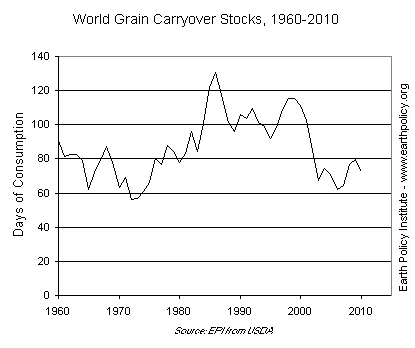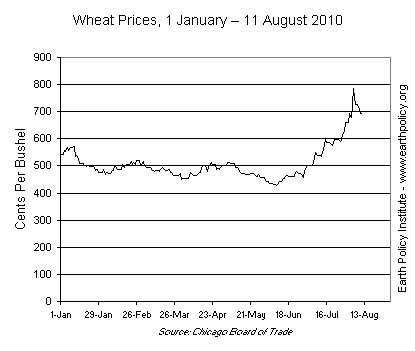"Oil wells go dry and coal seams run out, but for the first time since the Industrial Revolution began we are investing in energy sources that can last forever." –Lester R. Brown, Plan B 4.0: Mobilizing to Save Civilization.
Estimates for this year’s global grain carryover stocks have fallen to 444 million tons, according to the U.S. Department of Agriculture’s August 12th World Agricultural Supply and Demand Estimates report. This amount of grain remaining in the world’s silos and stockpiles when the next harvest begins is enough to meet 72 days of consumption.
“This drop in world carryover stocks of grain to 72 days of consumption is moving us uncomfortably close to the 64 days of carryover stocks in 2007 that fueled the 2007–08 spike in world food prices,” says Lester R. Brown, president of Earth Policy Institute.
A searing record heat wave, severe drought, and relentless wildfires in Russia and Central Europe have decimated the region’s harvests. Russia’s wheat production is now estimated at 45 million tons, a 27 percent drop from last year. In Kazakhstan, the wheat harvest is down 32 percent to 12 million tons, and in Ukraine it is 17 million tons, 19 percent smaller than in 2009. On August 5, Russia announced that it was banning grain exports at least through the end of the year and requested that neighboring countries do the same. Since these three countries typically supply a fourth of world wheat exports, wheat prices have risen along with the region’s temperature.
Russia runs the risk of drought spillover into the next year if there is not enough soil moisture to plant the new winter wheat crop. With soils parched, planting time only days away, and not much rain in prospect, this is a growing concern in Moscow, and indeed in the world.
Longer, more-intense heat waves and dangerous wildfires are consistent with projections for a warming world.
“Rising temperatures and food security do not mix,” notes Brown. “The situation in Russia gives us a preview of what could be in store if we continue to overheat our planet. This should be a wake-up call for the world: to protect our food security we need to dramatically cut carbon dioxide emissions. We cannot continue to burn coal and oil with abandon and expect to have bumper harvests that can keep up with the record demand generated by population growth and the increasing use of grain to feed livestock and to fuel cars.”
Lester Brown’s latest book, Plan B 4.0: Mobilizing to Save Civilization, presents a plan for a wartime-style mobilization to cut global net carbon emissions 80 percent by 2020.
Media availability: Reporters wishing to interview Lester R. Brown on food security and climate connections can call 202-496-9290 x 10 or send an email to [email protected].
Additional resources:
Lester R. Brown, “Rising Temperatures Raise Food Prices: Heat, Drought, and a Failed Harvest in Russia,” Plan B Update, 10 August 2010. (article and teleconference audio recording)
Lester R. Brown, Plan B 4.0: Mobilizing to Save Civilization (New York: W.W. Norton & Company, 2009). Free book download at www.earth-policy.org/books/pb4.
Lester R. Brown, Janet Larsen, Jonathan G. Dorn, and Frances C. Moore, “Time for Plan B: Cutting Carbon Emissions 80 Percent by 2020,” 2 July 2008.
Janet Larsen, “Inferno on Earth: Wildfires Spreading as Temperatures Rise,” Plan B Update, 19 November 2009.
Janet Larsen, “Setting the Record Straight: More than 52,000 Europeans Died from Heat in Summer 2003,” Plan B Update, 28 July 2006.
Amy Heinzerling, “Global Carbon Dioxide Emissions Fall in 2009 - Past Decade Still Sees Rapid Emissions Growth,” Eco-Economy Indicator, 20 July 2010.
Amy Heinzerling, “Past Decade the Hottest on Record,” Eco-Economy Indicator, 14 January 2010.”


 Print:
Print:  Email
Email

